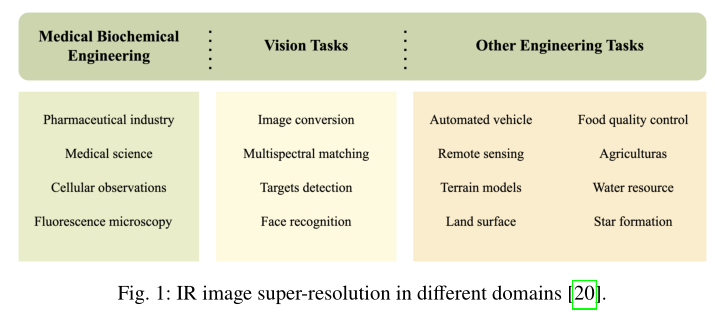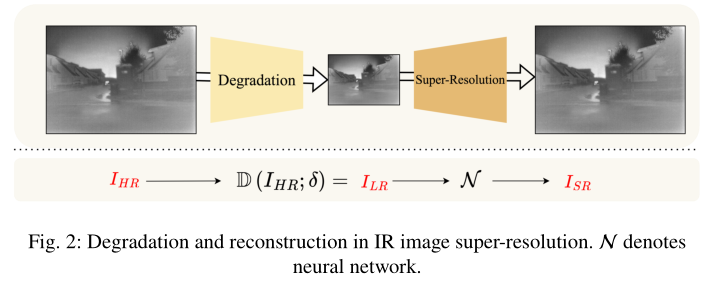The ability to generate models that accurately fit the distribution of data has led to their widespread adoption and success in fields such as computer vision and natural language processing. In this chapter, we provide a brief overview of the applications of generative models in the field of infrared image super-resolution, including a discussion of the various challenges and adversarial training methods employed. We propose the potential research and development areas for the application of infrared image super-resolution generation models.
In modern society, infrared images play an irreplaceable role in industry and daily life. While visible light images can more easily convey information to people, in certain environments, such as earthquake rescue and safety, there is not enough light and people have to turn to infrared images. Compared to visible light images, infrared images can better withstand harsh natural environments and provide a wealth of information about heat sources. This valuable feedback can help people judge the condition of outdoor equipment and individuals in order to repair damaged infrastructure or help people in distress. Considering these important applications, there is an urgent need for high-resolution (HR) infrared images. However, due to the limitations of existing optical devices, the resolution of infrared images is not satisfactory. With the growing interest of the deep learning community in generative adversarial networks (GANs)[12], adversarial training methods that introduce infrared image super-resolution have been put on the agenda [14,28,40,56]. In this section, we will first introduce the application of infrared imaging and discuss some key areas. Then the basic composition and challenges of infrared imaging system are introduced.
The super-resolution of infrared images is an attractive approach in a wide range of real-world situations. We will cover some of these typical areas, such as medical engineering and engineering tasks. Then, other approaches will be briefly discussed. The application of infrared image super resolution is shown in Figure 1

In the field of medical engineering, degenerative diseases of the nervous system have been of great concern. If we can understand the mechanisms behind these diseases, we will have the opportunity to completely treat diseases such as Alzheimer's disease that seriously affect the quality of life of older people in later life. Understanding the mechanisms of these diseases requires pathological analysis before treatment options can be determined. One of these materials, CRANAD-2, a neurogenic curcumin derivative, is thought to contribute to these studies [6,52]. CRANAD-2 can be detected in infrared images. High-resolution infrared images will be conducive to near-infrared nanoimaging and further promote the development of related research.
A case in point is the COVID-19 pandemic, which has drawn much attention recently. Considering the uneven development between different countries and regions, this will cause an imbalance in medical resources. In addition, a factor affecting early detection of COVID-19 in developing countries is the absence of expensive lung imaging equipment. Many doctors have tried to use faster and cheaper X-ray images as a tool for disease diagnosis [8,39].
Infrared imaging plays an important role in the field of engineering. Infrared cameras can be used to detect temperature changes in the system [22], which helps to identify overheated components that may indicate a potential failure or malfunction. In electrical engineering, this is especially useful when detecting overheated components that can cause power outages or other problems. Infrared imaging can also be used to detect leaks in gas or liquid systems, such as pipelines [1], enabling engineers to quickly locate and repair these problems, avoiding costly damage and downtime. In addition, infrared imaging can be used to monitor the performance of systems and equipment, enabling engineers to identify potential problems before they become more serious and take steps to prevent costly failures or downtime [7].
In addition, infrared images have an important role in other fields. Infrared imaging can be used for ecosystem health monitoring and assessment in the field of environmental protection [38,45,61], especially in areas that are difficult to access or study with traditional methods. Infrared cameras can provide useful information about the health of plants, animals and other living things by detecting changes in temperature. This enables conservationists and scientists to identify potential difficulties and take steps to protect the environment. In addition, infrared imaging can be used to monitor the health and productivity of crops in the agricultural sector [3,9,36,46]. Infrared cameras can help farmers identify underperforming areas of the field by detecting changes in temperature. This enables farmers to take action to increase yields and reduce the likelihood of crop failure. In addition, identifying pests and diseases, infrared imagery enables farmers to protect their crops and increase overall productivity. In the food industry, infrared cameras can also help identify areas of food that are not being cooked or stored properly by detecting temperature changes. This enables food manufacturers to take action to stop the spread of foodborne illnesses. During food processing, infrared imaging is used to monitor its quality [41,53], enabling manufacturers to identify potential problems and improve product quality. In deep space exploration, infrared cameras can provide useful information about the composition and structure of planets, moons and other objects in the solar system by detecting temperature changes. This helps scientists better understand the origin and evolution of the universe. [5,42]
Overall, infrared imaging is a versatile and powerful tool that can be used in a variety of different fields, providing valuable information and improving our understanding of the world around us.
The connection between temperature and the amount of infrared radiation emitted by an object is one of the foundations of infrared imaging [19,23,29,47]. Objects produce more infrared radiation at higher temperatures than at lower temperatures. Thanks to this connection, infrared cameras can produce images based on the amount of infrared radiation produced by objects in their field of view and detect changes in temperature. The need for specialized equipment is one of the major challenges of infrared imaging. Special cameras or sensors are needed to detect and quantify infrared radiation because it is invisible to the naked eye. These cameras and sensors can be expensive, and their effective use may require specialized training. The requirement for precision instrument calibration and adjustment is another difficulty in infrared imaging. Infrared cameras and sensors must be properly calibrated to provide accurate and reliable data, as they are sensitive to temperature changes [11,25,26,49,54]. This can take a lot of time and requires specialized knowledge. In addition, there are various variables, including air conditions, ambient temperature, and the presence of other infrared radiation sources, that can affect infrared imaging. These aspects must be carefully considered when analyzing and utilizing infrared images, as they have the potential to alter the accuracy and reliability of the image.
In this section, we will discuss adversarial training methods in super resolution, including problem definition and adversarial training framework. For the definition of the problem, we will cover the components of super resolution. Then, the adversarial training framework under super resolution is presented.
Superresolution is a technique in the field of computer vision and image processing that involves constructing high-resolution images from one or more low-resolution counterparts [10,34,44,57]. This method can be used in a variety of situations, including enhancing images from low-resolution cameras or sensors and enhancing photos for medical or scientific research. A more detailed problem definition is shown in Formula 1:

Where D is the degradation function, IHR is the high-resolution infrared image, ILR is the low-resolution infrared image, and is the parameter of the degradation process. The visualization of super-resolution degradation and reconstruction of infrared images is shown in Figure 2.


Where IHR⊗k represents the convolution between fuzzy kernel k and HR image IHR. In k, there is noise and compression. And ↓d is the downsampling factor, such as 4x and 8x. Simply put, the super-resolution reconstruction objective function of infrared images can be described as formula 3:

Where L is the loss function between HR image IHR and SR image ISR. Φ(θ) and λ are regularization terms and penalty parameters, respectively. More details on the definition of infrared image super resolution can be found in this literature [20].
In this chapter, we discuss the potential applications and future directions of generative models in the super-resolution background of infrared images. The application of generative adversarial networks (GANs) in super-resolution tasks has attracted a lot of attention, especially in the field of infrared images with unique patterns. Researchers have made significant progress in this area by developing new module designs and integrating additional information. It is expected that new generative models, such as diffusion models, will continue to drive advances in this field.